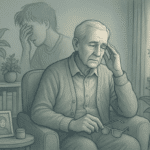At some point in almost every person’s life, an experience so deeply distressing will occur that it can be deemed a traumatic experience. This occurrence may be the death of a loved one, a series of unfortunate and often catastrophic events, or simply the witnessing of something personally unbearable. Trauma is traditionally defined as a “deeply distressing or disturbing experience”. Traumatic events can even provoke some to seek out trauma therapy. Trauma therapy has been found to be extremely helpful in treating those who have experienced trauma as a child or adult who wish to seek a better quality of being.
Before discussing how trauma can cause mental illness, it is important to understand that what may be traumatic to some, may not be traumatic to others. An incident that may be deeply distressing to an individual should not be invalidated based on the personal opinion of anyone else.
With this being said, the ways in which we can all become a part of the change in helping traumatic wounds become badges of healing and strength, the types of trauma that exist must also be established and considered. So, what are some types of trauma?
The Missouri Department of Mental Health mentions on their website for childhood trauma some examples of traumatic experiences including (but not limited to): natural disasters, physical abuse, sexual abuse, domestic violence, medical injury, neglect or deprivation, community violence, grief, kidnapping, school violence, and loss. What should also be understood, according the DMH, is that there are also three types of trauma. The first type of trauma, Acute Trauma, results from one singular incident. The second is Chronic Trauma, which is “repeated and prolonged”. Third, Complex Trauma is “exposure to varied and multiple traumatic events, often of an invasive, interpersonal nature.”
Of course, these three types of trauma may overlap, and the degree of emotional hardship or adversity caused by each can vary for each individual. No matter the period of the victim’s life, the experiences mentioned above can be deeply distressing. For some, however, deeply distressing can quickly transform into chronically painful if never emotionally processed or properly treated.
It is strongly speculated in the world of psychology and neurobiology that indeed, many mental illnesses may bear their roots in childhood and adult trauma. Studies have been done whose results even support such theories. Reiterating this claim, such a journal written by C.B. Nemeroff, an American psychiatrist who researched at University, in his article printed in The Journal of Clinical Psychiatry mentions the following:
“There is considerable evidence to suggest that adverse early-life experiences have a profound effect on the developing brain. Neurobiological changes that occur in response to untoward early-life stress can lead to lifelong psychiatric sequelae. Children who are exposed to sexual or physical abuse or the death of a parent are at higher risk for development of depressive and anxiety disorders later in life. Preclinical and clinical studies have shown that repeated early-life stress leads to alterations in central neurobiological systems, particularly in the corticotropin-releasing factor system, leading to increased responsiveness to stress. Clearly, exposure to early-life stressors leads to neurobiological changes that increase the risk of psychopathology in both children and adults. Identification of the neurobiological substrates that are affected by adverse experiences in early life should lead to the development of more effective treatments for these disorders. The preclinical and clinical studies evaluating the consequences of early-life stress are reviewed.”
Gabor Mate, a renowned canadian psychologist who studies the role of trauma in the development of ADHD in children and adults, states “It is impossible to understand addiction without asking what relief the addict finds, or hopes to find, in the drug or the addictive behaviour.” Addiction has a purpose, in a sense. This purpose is to find relief from something, and all too often that “something” is the mental anguish of memory. Similarly, anxiety has a purpose as well. Being a means of protection developed by our brains the most ancient origins of human biology, anxiety disorders develop as a type of “overreaction” of these pre-existing safeguards in the brain.
Gabor Mate also speaks heavily on the grounds that most addictions stem from traumatic experiences, whether this be neglect or other types of abuse.
Traumatic events cannot always be prevented, and we sadly cannot always protect ourselves or our children from the harsh trials of life. So, how can we help, and how can we become a part of the change?
Trauma Therapy
There are various types of trauma therapy, all of which have their own important purpose and place in the field itself. The aim of trauma therapy is to assist those suffering from PTSD, Anxiety, Depression, drug and alcohol addictions, behavioral addictions, eating disorders, and other mental illnesses that may have developed as a result of the traumatic experiences of their past reach a state of relief from their mental anguish. In order to do this, traumatic events must be fully processed emotionally, something in which all every type of trauma therapy aims to accomplish. This way, the sufferer of traumatic memories is able to reach a dynamic and thorough understanding of their trauma, function appropriately in society, and reach an overall state of well-being. How can someone suffering from trauma, or from a mental illness tied deeply to a past traumatic experience, get help? The first course of action is usually one, or multiple, of many forms of trauma therapy.
There are many types of trauma therapy, but some include;
- CBT: Cognitive Behavioral Therapy is a form of “talk” therapy. Certain methods used in CBT to help those recovering from traumatic events include exposure therapy as well as cognitive processing therapy.
- EMDR: Eye movement desensitization is a type of therapy that was developed for the sole purpose of processing traumatic events in someone’s memory in a way that helps the sufferer be less negatively affected when remembering their trauma. It involves talking about the trauma, or remembering it, whilst also following visual cues, such as flashing lights or the moving finger of the trauma therapist, alongside thinking a positive thought. EMDR has been proven highly effective in the treatment of PTSD.
- Pharmaceutical drugs: SSRIs are a common course of action when it comes to treating disorders such as anxiety, depression, PTSD, and eating disorders that were formed due to trauma. Treatment is individual and personal and should be discussed with a psychiatrist. Pharmaceuticals such as Prozac or Zoloft can often help the parts of the brain that process danger become less inappropriately active.
Trauma is an underlying cause of many addictions and mental disorders, but what is to be understood is how trauma therapy can help alleviate the root cause of all of these ailments. There is hope and help for those who suffer from PTSD and other mental illnesses that developed because of the chemical changes that take place in one’s brain when they are placed in a situation that is too distressing to cope with. In order to be a part of the change, we must understand that mental illnesses are often due not just to biological causes, but also to environmental events that affected the brain of someone who is suffering from a mental illness. Spreading awareness of the types of trauma therapy and how they can help sufferers of mental illnesses recover sheds light on a new beginning for victims of trauma everywhere.












